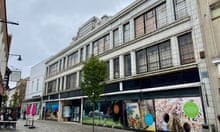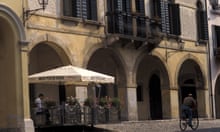I should have known we couldn’t handle the wave. Far from the beach, my four-year-old daughter and I clung to each other in water up to my chest. Swimmers around us screamed in anticipation. I backed up and stumbled as we braced ourselves to meet the wall of water that was now a whitecap above our heads.
“Look away!” I shouted at the moment of peak pointlessness. The water shot into our nostrils, scouring sinuses with a chlorine burn. We gasped and rubbed our faces before staggering to the vinyl-clad shoreline, laughing like the fools we clearly were for having paid roughly £55 to (almost) drown in the world’s largest indoor wave pool.
World Waterpark is one of the many super-sized attractions in my local shopping centre – which happens to be the largest mall in North America, and was once the biggest in the world.
Recently, I have questioned whether time spent at West Edmonton Mall is time well spent. Only a five minute drive from my home in the Alberta capital, and with a car park that can accommodate 20,000 vehicles, I used to be embarrassed that my hometown’s reputation could depend so heavily on it. I sniffed at the culture of consumerism it represented – and what it took away from the character of the community.
My mother offers the best example of the mall’s effectiveness as an insulator. On 31 July 1987, Edmonton was hit by a tornado that killed 27 people and destroyed 300 homes. My mother, who adores West Edmonton Mall, was shopping there with her sister, who was visiting from England.
“When we came out all the streets were flooded,” she recalls. “We missed the whole thing. We had a fabulous day, but we were shocked when we came out.”

The North American enclosed mall emerged to make the onerous tasks of domestic hunting and gathering convenient and enjoyable. Since opening in 1981, Edmonton’s mall has strived to add “wondrous” to that list, landing somewhere between grand and garish.
In an era when about a third of US malls are expected to close because of failing department stores and lapsing consumer interest, West Edmonton Mall appears to thrive.
Thirty years ago, it drew roughly 20 million people a year, about twice the number who visited Disneyland, California. Today, its 800 shops draw 30 million visitors a year, and it sees almost 10 times the traffic of Banff – Alberta’s most popular Rocky Mountain park – making it the province’s top attraction. But then, wilderness isn’t our natural habitat anyway ... thanks to climate control and myriad spectacles for our shortened attention spans, maybe the mall (and West Edmonton Mall in particular) still is.
“There’s something about the formula they’ve created that warrants it’s going to be busy,” says Renee Williams, director of Edmonton Tourism. “It’s not just shopping, right?”
A retail ‘city’
After more than three decades, West Edmonton Mall remains one of the defining features of my city. Despite having two toddlers who get as much fulfilment from the mall as I once did by getting as far from it as possible, this surprises me.
The biggest reason is that enclosed malls don’t align with the tenets of modern city building. They’re destinations that amass people, but not exercises, in “placemaking” – that activity city planners deem essential to creating community. As Mack Male, a prominent Edmonton blogger on local affairs, has said about such efforts in the city: “It’s not just about filling a space with people. It’s about connecting people with one another. That’s what turns space into place.”
Generally, malls struggle to make the transition in two significant ways. Firstly, shopping doesn’t promote unity; it’s a form of personal fulfilment that requires no collaboration other than with a sales clerk (or, when online, no one). By nature, the mall cuts us off from one another by encouraging the individual pursuit of stuff.
Secondly, enclosed malls cut us off from the world. Or in the case of West Edmonton Mall, it can seem to become that world (its owner, TripleFive, calls it an entertainment and retail “city”). I would even argue that it undermines placemaking efforts beyond the 48 city blocks it occupies.

When it first opened at a mere 1.1m sq ft, “the new mall was just considered another suburban shopping centre”, according to a 1987 report by the city of Edmonton in response to public concern over the mall and “its impacts”.
That naivety was remedied by – among other ill effects – an 8% economic decline in the downtown core, only now recovering thanks to a recently built National Hockey League arena. A mall actually opened downtown in 1987 in answer to West Edmonton Mall, with the hope it would pull people back to the core.
Today, revitalisation efforts tacitly focus on drawing people away from both malls, and on encouraging the proliferation of street level, independent cafes and businesses that “inject the gaiety, the wonder, the cheerful hurly-burly that make people want to come into the city and to linger there”, as Jane Jacobs once wrote. Of American cities’ new breed of self-contained civic centres, she was scathing: “They banish the street. They banish its function. They banish its variety.” That was 1958. Now we’re beckoning all of that back.
I love downtown with its growing collection of patios and the way people waste time doing little but watching each other – in summer, at least. As I write, however, the wind chill is driving the temperature to -28 C, and I can’t imagine a worse place to be than the city’s currently icy heart, especially with children.
So, there’s the mall. For many local parents (including my wife, who mall-walked the kids during two maternity leaves), West Edmonton Mall can resolve the terrifying uncertainty of what to do in Alberta’s cryogenic mid-winter. I remember my mother turning to it for salvation, bringing us in from the nearby small suburban city where I grew up. “I can’t believe that you’ll take the girls there now,” she says now. “Because you hated it.”
The fact is, West Edmonton Mall fulfils a need in the city as a vast expanse of quasi-public space. It is, at certain times of the year, an easy access biosphere in inhospitable terrain. Apart from the rare treat of a visit to the water park, the kids and I rarely spend a penny on the attractions; there’s no need.
Instead, we watch skaters glide across the Olympic-sized rink, visit forlorn-looking puppies at the pet store, eat cheap doughnuts. We merge in and out of a meandering crowd of shoppers, and participate as fully as one can in a community united only by big name brands and the bizarreness of the surroundings.
“The mall is, at heart, just another ancient organising principle that hasn’t yet outlived its usefulness,” writes Paco Underhill in Call of the Mall, the consumer-habit expert’s look at the culture of shopping.
In the effort to build better cities, West Edmonton Mall may not qualify as a maker of “place”. But is it more than just space? It’s popularity suggests it might be. “It’s not dying,” Williams says. “It’s got a good long life ahead of it.”
Follow Guardian Cities on Twitter and Facebook and join the discussion. You can revisit our Guardian Canada Week here











Comments (…)
Sign in or create your Guardian account to join the discussion